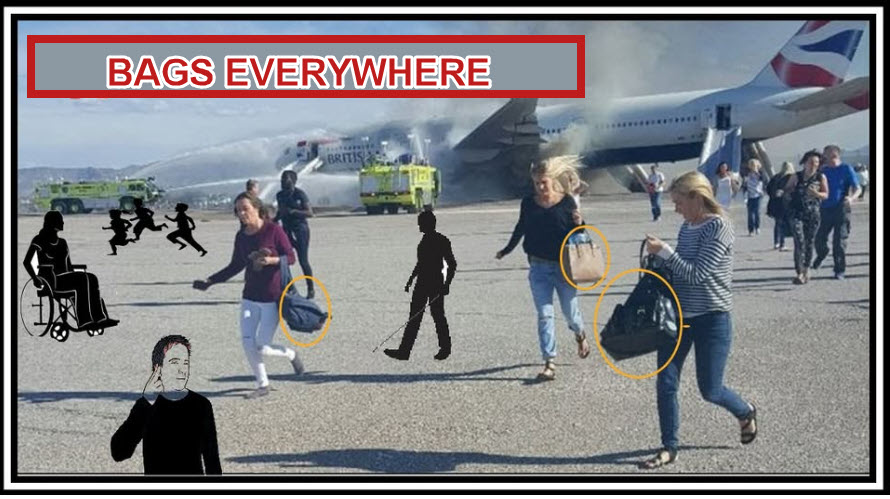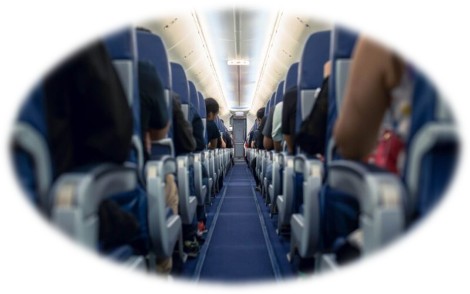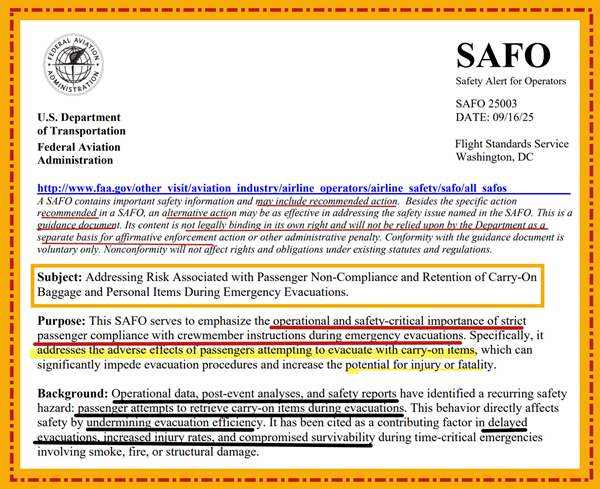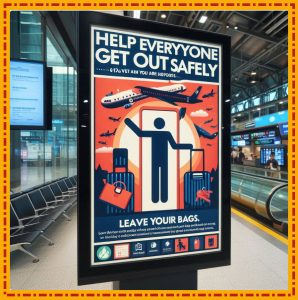SAFO “emergency evacuations pax and bags” will lead useful, practical approaches

Recent events and a long list of prior problems have highlighted the REQUIREMENT that passengers exiting in an emergency situation MUST NOT TAKE THEIR CARRY-ONS. Though these near tragedies should have instructed future customers to abide by this SAFETY MANDATE, those fleeing from a distressed airliner, persist in grabbing their bags.
Here is a small sample these lessons:
- 2018— Enough Thinking, Time to do something about Passengers carrying bags off in an emergency-
- 2022— Reality Check on the Emergency Vacating of Aircraft Cabin (EVAC) Act
- 2024-Quick, Initial, But Important, Safety Lessons From JAL 516
This issue is the subject of an FAA SAFO 25003 which poses a dilemma for the airlines. Specifically, this GUIDANCE was sent to all airlines in response to this safety risk trend:
“… Operational data, post-event analyses, and safety reports have identified a recurring safety hazard: PASSENGER ATTEMPTS TO RETRIEVE CARRY-ON ITEMS DURING EVACUATIONS. This behavior directly affects safety by undermining evacuation efficiency. It has been cited as a contributing factor in delayed evacuations, increased injury rates, and compromised survivability during time-critical emergencies involving smoke, fire, or structural damage.”
And the FAA suggested that the carriers take action along these lines:
“Recommended Action: Operators should evaluate their emergency evacuation procedures, training and emergency announcements and commands to ADDRESS PASSENGER NON-COMPLIANCE PARTICULARLY IN RELATION TO CARRY-ON ITEM RETRIEVAL. A coordinated approach rooted in regulatory compliance, operational best practice, and clear public communication may contribute significantly to reducing evacuation times and preserving life in time-critical emergencies. Operators should consider the following:
- Safety Management System (SMS)…
- Safety Briefings…
- Passenger Outreach and Education Campaigns… “
A MASSIVE ROCK and AN EQUALLY LARGE HARD PLACE lies between these two points
- Reminding passengers of safety risks are thought to deter repeat flights—NOT GOOD FOR REVENUE.
- It is important that passengers’ AWARENESS—that taking personal property off the aircraft in an emergency—LIKELY RESULTS IN SIGNIFICANT PROBLEMS FOR THEIR SAFETY AND THAT OF FELLOW PASSENGERS
Traditionalists, those who were convinced that enforcement was a REAL DETERANT, are uncomfortable with SAFOs; they argue that any safety risk which merits notice to all operators should be an FAR. This SAFO speaks to this Alert is a good addition to regulatory safety risk management.
This form of communicating is a more expeditious means of getting important safety information to the industry. An NPRM requires layers of review that delay its display. A similar rule promulgation is that the development of the new rule delays the issuance of an NPRM. When mandating a practice, FAA staff takes a lot of time to divine what is THE right solution for the target of the new rule.
A SAFO, like an Advisory Circular, allows the certificate holder to design a way to attack the risk that is truly relevant to its operations. The professionals
who have been managing their crews
and
who have superior familiarity with their passengers
are more likely to be MORE able fix the problem in a set of practices and procedures than the FAA staff who have limited or no airline operational experience.
An airline’s customer may find Poster A’s message too strong and another company might know their audience would respond to it. The purely visual message of Poster B might work better for another airline’s frequent flyers.
It will be interesting to see what innovative approaches are developed in crew training, onboard safety reviews, and consumer messaging!!!
FAA tells airlines to retrain passengers to leave bags during evacuations
September 20, 2025,
Shutterstock
The Federal Aviation Administration is telling US airlines to get tougher about a message that’s often ignored during cabin emergencies by ensuring the passengers know THEY MUST LEAVE THEIR CARRY-ON BAGS BEHIND.
On September 16, 2025, the agency issued a new Safety Alert for Operators (SAFO 25003), titled “Addressing Risk Associated with Passenger Non-Compliance and RETENTION OF CARRY-ON BAGGAGE AND PERSONAL ITEMS During Emergency Evacuations.” The alert points to repeated instances in which passengers have tried to grab their belongings before escaping, slowing evacuations, creating hazards in crowded aisles, and in some cases damaging inflatable slides.
In a follow-up statement on September 19, the FAA urged carriers to “re-evaluate their emergency evacuation procedures, flight-crew training, announcements and commands” to drive home the message. The agency said it has documented several evacuations where passengers’ attempts to remove luggage DELAYED EXITS AND COMPROMISED SAFETY EQUIPMENT.
The new guidance is not a regulation, but it does carry weight. SAFOs are considered strong recommendations from the FAA’s Flight Standards Service, and the agency expects operators to take them seriously[1]. In this case, the agency cites operational data and safety reports showing that passenger non-compliance is a recurring and potentially deadly problem. Risks include blocked aisles, trip-and-fall hazards, evacuations that take longer than survival conditions allow, and higher injury and fatality rates, the FAA said.
To reduce those risks, the FAA is calling on airlines to review their training programs and public-address scripts so the instructions are clear, firm, and leave no room for interpretation: passengers are to evacuate without their bags, period. Exit-row briefings are singled out for particular review, with airlines asked to ensure they are effective and consistently delivered.
The agency is also encouraging airlines to expand passenger education beyond the aircraft cabin. That could mean adding new signage or videos in terminals and boarding areas, incorporating symbols that cross language barriers, and using simple messages that stress group safety — for example, “HELP EVERYONE GET OUT SAFELY — LEAVE YOUR BAGS.”
On the operational side, carriers are advised to address the issue within their Safety Management Systems, assessing how current procedures stack up against the hazard of non-compliance. That may include adding scenarios to crew training in which passengers reach for carry-ons, checking that written and recorded announcements all use the same language, and ensuring appropriate signage drives home the point.
What happens next will depend on how carriers act in the coming weeks. Airlines are expected to respond by updating preflight safety demonstrations, revising safety cards, and possibly adopting standardized phrasing.
The FAA will be looking for updated crew training, new passenger-facing materials, and changes to onboard announcements. The message from regulators is clear: EVERY SECOND COUNTS IN AN EVACUATION AND LEAVING BAGS BEHIND CAN MEAN THE DIFFERENCE BETWEEN A SAFE EXIT AND OR AN AVOIDABLE TRAGEDY.
[1] The SAFO is very clear that its recommendation DOES NOT CONSTITUE A REGULATORY REQUIREMENT.






